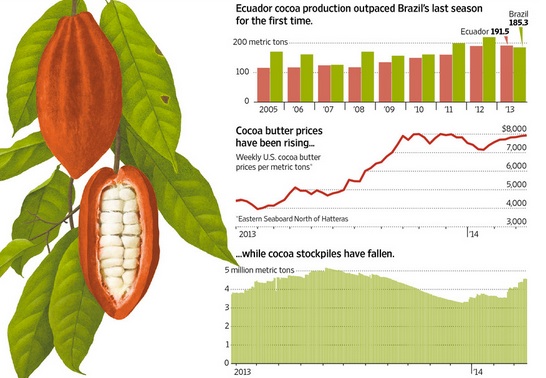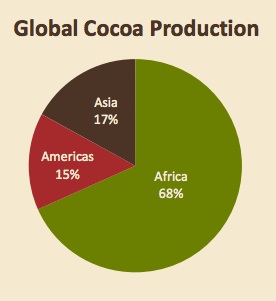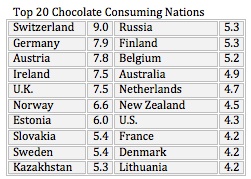
Weekly Roundup: From New Drachma to Old Monetary Dilemmas
February 14, 2015
Monopoly Game Surprises
February 16, 2015The world is experiencing a chocolate deficit.
Struck by frosty pod rot and other fungal diseases, the world’s cocoa crop has shrunk by 30 to 40 percent. Add to that weather problems in Ivory Coast and Ghana where we get 70 percent of the world’s cocoa production and you have us eating much more than we produce.
Where are we going? To supply and demand chocolate problems.
More Cocoa Beans
On the supply side, the solution could be CCN 51. A new bean developed in Ecuador, CCN 51 is more resilient and prolific. There is only one problem…the taste. Words used to describe how CCN 51 tastes include sour, acidic, dirt. But still, chocolate makers are blending it with their traditional beans. (Sound familiar? A new seed is more resilient but, like many strawberries and tomatoes, the good flavor is gone.)
Increasing supply, CCN 51 moved Ecuador into a top South American producing slot.

From: WSJ
But still, most production comes from Africa with Ivory Coast #1.

From: World Cocoa Foundation
More Chocolate Eaters
On the demand side, more affluence means more chocolate. That takes us to the BRICs (Brazil, Russia, India, China) and the MINTs (Mexico, Indonesia, Nigeria, Turkey) where we have an aspirational middle class whose diet is changing and single size portions that cost pennies for those who have less. We also have the Russian people who are already among the world’s top 20 chocolate eaters.
Still per capita (kg) chocolate consumption in developing countries is tiny. China’s .2 kg is just 7 ounces.:

From: Confectionery News
Among more developed economies, total chocolate consumption has pretty much plateaued. The Swiss top the list with a whopping 20 pounds of chocolate per person annually, at 9.5 pounds a year, U.S. per capita consumption is down slightly and, in Eastern Europe, it is going up.
The biggest chocolate eaters (2014 per capita/kg):

From: Confectionery News
Our Bottom Line: The Power of the Market
Chocolate is a market story. With no one saying grow more, the supply side of the market responded with innovation. Meanwhile, as developing nations move up the spending ladder, they are transforming the demand side of commodities markets.
However, thinking of those new beans, I wonder whether all of us will be happy with what the market decided. And that will mean that we will still have a chocolate deficit.
![econlifelogotrademarkedwebsitelogo[1]](/wp-content/uploads/2024/05/econlifelogotrademarkedwebsitelogo1.png#100878)



